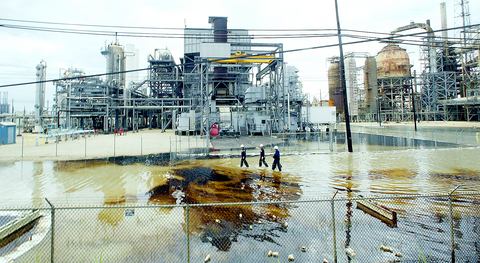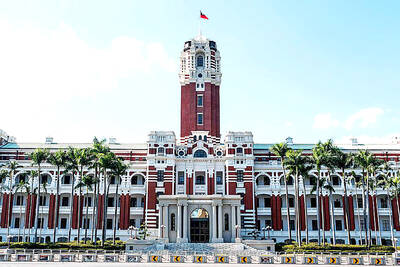Hurricane Rita caused some damage to oil refineries near the Texas-Louisiana border and raised the prospect of gasoline shortages and higher prices during the arduous process of restarting refineries all along the Gulf Coast. But it did not cause the widespread destruction of the energy infrastructure that some had feared.
On the edge of this workaday city of refineries and modest ranch houses near Galveston, a flare burned silently from a tower at the large BP refinery on Saturday afternoon, evidence that it was largely unscathed.
Up and down the energy corridor between Galveston and Houston, industry officials said refining locations had managed to avoid extensive damage from the hurricane, which made landfall to the east, near the Louisiana border.

PHOTO: AP
Refineries sat waiting for workers to return to assess their conditions. In Texas City, there were no signs of wind damage or flooding at any refining installations.
Egrets gathered in the marshes in the shadow of refineries and petrochemical complexes owned by energy giants like Valero, BP, Marathon-Ashland and Praxair. A toppled sign from a Phillips 66 gas station was the only indication that a hurricane's edge had passed through.
The situation was less sanguine in and near Port Arthur, Texas, and Lake Charles, Louisiana, near the Texas-Louisiana border, where officials said they expected refineries and industrial plants to be out of service longer because of heavy wind damage, power failures and scattered flooding.
Depending on how much of the US' already stretched refining capacity is affected and for how long, that could cause shortages of gasoline and other fuels and push up retail prices again.
"It looks like we may have dodged some of the bullet in terms of the impact," said John Felmy, chief economist for the American Petroleum Institute. "It certainly is better than if it had hit some of the bigger refining centers."
Chuck Dunlap, who rode out the storm with 50 others at Pasadena Refining Systems, just outside Houston, said that at first glance, his plant and other facilities in the area appeared to have sustained limited damage. But even so, it will take a few days for his plant, which normally processes about 100,000 barrels of crude oil a day, to return to full speed.
"We are now actually walking through the plant and doing a more detailed inspection," said Dunlap, the refinery's president. "We won't be at full operations till midweek."
As the hurricane approached Texas on Friday, Galveston and Houston seemed directly in its path, and had the storm plowed into those cities, laden with petroleum-tank farms, refineries and natural-gas processing plants, insurance experts feared that losses could have run to US$30 billion. But initial estimates put insured damage at US$5 billion or less.
With hurricane winds extending 110km from the center of the storm, Galveston and Houston got heavy rain and strong gusts of more than 120kph, and they sustained scattered damage. Royal Dutch Shell and Valero Energy said their Houston-area plants would be restarted as workers returned and power was fully restored.
Companies shut down 16 big refineries that make up about 23 percent of the nation's capacity in the days before Hurricane Rita struck. Less than half of the facilities that closed were in or near Port Arthur or Lake Charles.
Valero and Shell both said the wind knocked down cooling towers and power lines at their Port Arthur refineries, but they reported minimal damage from flooding. Valero said it would take two weeks to a month to complete repairs and restart the plant.

The CIA has a message for Chinese government officials worried about their place in Chinese President Xi Jinping’s (習近平) government: Come work with us. The agency released two Mandarin-language videos on social media on Thursday inviting disgruntled officials to contact the CIA. The recruitment videos posted on YouTube and X racked up more than 5 million views combined in their first day. The outreach comes as CIA Director John Ratcliffe has vowed to boost the agency’s use of intelligence from human sources and its focus on China, which has recently targeted US officials with its own espionage operations. The videos are “aimed at

STEADFAST FRIEND: The bills encourage increased Taiwan-US engagement and address China’s distortion of UN Resolution 2758 to isolate Taiwan internationally The Presidential Office yesterday thanked the US House of Representatives for unanimously passing two Taiwan-related bills highlighting its solid support for Taiwan’s democracy and global participation, and for deepening bilateral relations. One of the bills, the Taiwan Assurance Implementation Act, requires the US Department of State to periodically review its guidelines for engagement with Taiwan, and report to the US Congress on the guidelines and plans to lift self-imposed limitations on US-Taiwan engagement. The other bill is the Taiwan International Solidarity Act, which clarifies that UN Resolution 2758 does not address the issue of the representation of Taiwan or its people in

US Indo-Pacific Commander Admiral Samuel Paparo on Friday expressed concern over the rate at which China is diversifying its military exercises, the Financial Times (FT) reported on Saturday. “The rates of change on the depth and breadth of their exercises is the one non-linear effect that I’ve seen in the last year that wakes me up at night or keeps me up at night,” Paparo was quoted by FT as saying while attending the annual Sedona Forum at the McCain Institute in Arizona. Paparo also expressed concern over the speed with which China was expanding its military. While the US

SHIFT: Taiwan’s better-than-expected first-quarter GDP and signs of weakness in the US have driven global capital back to emerging markets, the central bank head said The central bank yesterday blamed market speculation for the steep rise in the local currency, and urged exporters and financial institutions to stay calm and stop panic sell-offs to avoid hurting their own profitability. The nation’s top monetary policymaker said that it would step in, if necessary, to maintain order and stability in the foreign exchange market. The remarks came as the NT dollar yesterday closed up NT$0.919 to NT$30.145 against the US dollar in Taipei trading, after rising as high as NT$29.59 in intraday trading. The local currency has surged 5.85 percent against the greenback over the past two sessions, central